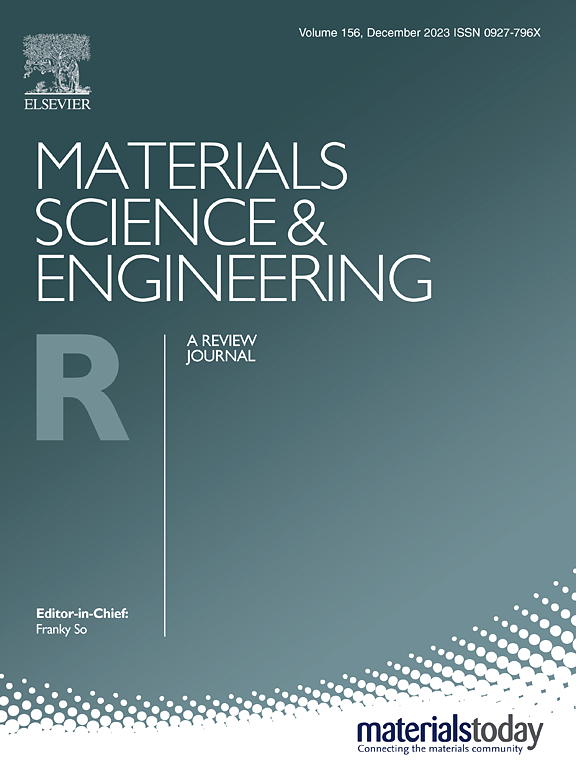选择性稳定CO2电还原制乙烯和乙醇CuOx催化剂的动态价态工程
IF 31.6
1区 材料科学
Q1 MATERIALS SCIENCE, MULTIDISCIPLINARY
引用次数: 0
摘要
cu基氧化物(CuOx)催化剂已成为电化学CO2还原成C2产品(如乙烯(C2H4)和乙醇(C2H5OH))的有希望的候选者。然而,同时实现高选择性和长期稳定性仍然是一个关键的挑战。本文系统总结了CuOx催化剂上碳-碳耦合的基本机理,重点介绍了动态价态、面效应、配位环境和局部反应微环境的作用。详细讨论了C2H4和C2H5OH的不同形成途径,重点讨论了中间演化、竞争吸附(*CO、*H、*OH)和电子结构调制。揭示了关键的结构-活性关系,为氧化态工程如何引导产品选择性提供了见解。同时,还分析了Cu⁺还原、粒子聚集和形态坍塌等降解途径,并对脉冲电解、异质结构构建、掺杂和表面涂层等先进的设计稳定性策略进行了评述。展望未来,operando表征、价界面精密工程和可扩展催化剂架构有望在实现二氧化碳到c2转化的工业实施中发挥关键作用。通过将机理理解与设计策略相结合,这项工作为合理开发高效耐用的CuOx催化剂提供了一个全面的框架。本文章由计算机程序翻译,如有差异,请以英文原文为准。
Dynamic valence engineering of CuOx catalysts for selective and stable CO2 electroreduction to ethylene and ethanol
Cu-based oxide (CuOx) catalysts have emerged as promising candidates for electrochemical CO2 reduction to C2 products such as ethylene (C2H4) and ethanol (C2H5OH). However, the simultaneous realization of high selectivity and long-term stability remains a critical challenge. This review systematically summarizes the fundamental mechanisms governing C–C coupling on CuOx catalysts, emphasizing the role of dynamic valence states, facet effects, coordination environments and local reaction microenvironments. The divergent formation pathways of C2H4 and C2H5OH are discussed in detail, focusing on intermediate evolution, competitive adsorption (*CO, *H, *OH) and electronic structure modulation. Key structure-activity relationships are revealed, offering insights into how oxidation state engineering can steer product selectivity. In parallel, degradation pathways such as Cu⁺ reduction, particle aggregation, and morphological collapse are analyzed, and advanced stability-by-design strategies including pulse electrolysis, heterostructure construction, doping, and surface coating are critically reviewed. Looking ahead, operando characterization, valence-interface precision engineering, and scalable catalyst architectures are expected to play critical roles in enabling the industrial implementation of CO2-to-C2 conversion. By bridging mechanistic understanding with design strategies, this work provides a comprehensive framework for the rational development of efficient and durable CuOx catalysts.
求助全文
通过发布文献求助,成功后即可免费获取论文全文。
去求助
来源期刊

Materials Science and Engineering: R: Reports
工程技术-材料科学:综合
CiteScore
60.50
自引率
0.30%
发文量
19
审稿时长
34 days
期刊介绍:
Materials Science & Engineering R: Reports is a journal that covers a wide range of topics in the field of materials science and engineering. It publishes both experimental and theoretical research papers, providing background information and critical assessments on various topics. The journal aims to publish high-quality and novel research papers and reviews.
The subject areas covered by the journal include Materials Science (General), Electronic Materials, Optical Materials, and Magnetic Materials. In addition to regular issues, the journal also publishes special issues on key themes in the field of materials science, including Energy Materials, Materials for Health, Materials Discovery, Innovation for High Value Manufacturing, and Sustainable Materials development.
 求助内容:
求助内容: 应助结果提醒方式:
应助结果提醒方式:


